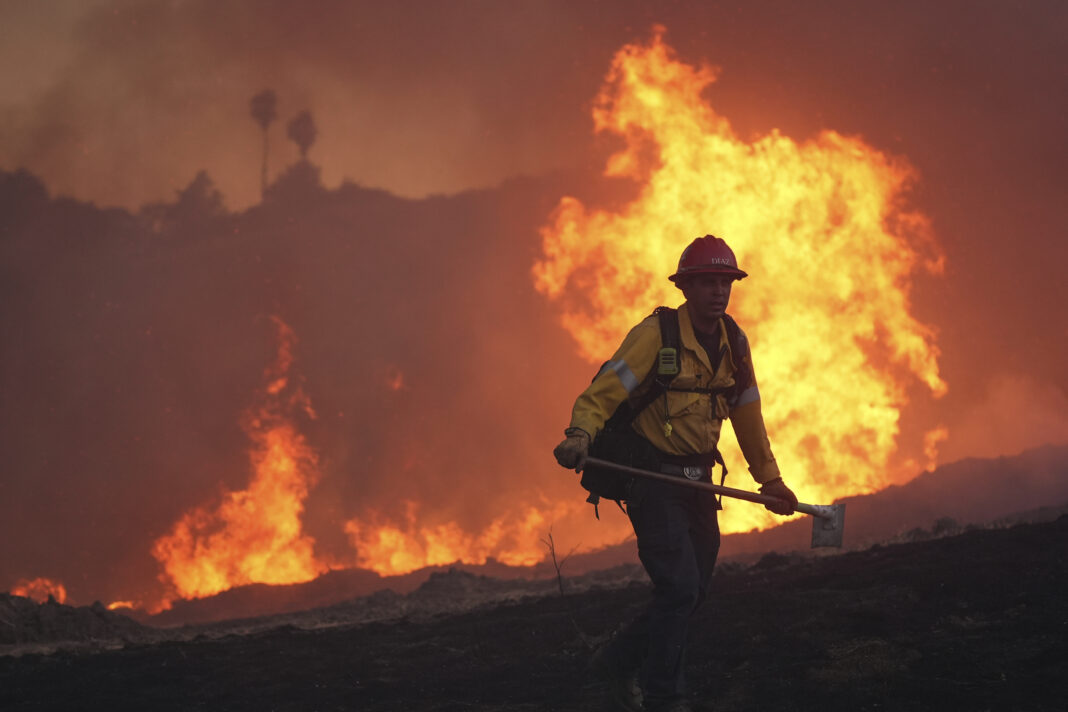- The Canyon Fire broke out Thursday around 2 p.m. northeast of Piru, California.
- Fueled by a heatwave and dry conditions, it rapidly expanded from 30 to 1,500 acres by late evening.
- Evacuation orders were issued for several communities in Ventura and Los Angeles counties. Firefighting crews and aircraft were deployed to combat the blaze.
A rapidly advancing wildfire northwest of Los Angeles has sent shockwaves through local communities. Urgent evacuations have been triggered as the blaze consumes more land by the hour. What began as a relatively small fire near the quiet town of Piru has now exploded into a destructive inferno. It is scorching a vast swath of territory spanning both Los Angeles and Ventura counties.
Initially estimated at around 30 acres when it ignited Thursday afternoon, the fire — now known as the Canyon Fire — has surged dramatically. It engulfed roughly 1,500 acres by late evening. Authorities are scrambling to contain the flames. These have been propelled by intense heat and dry winds linked to a recent heatwave. The National Weather Service reported temperatures nearly hitting 100 degrees near Lake Piru. This created a perilous environment for firefighting efforts.
From Quiet Town to Evacuation Zone: How the Fire Spread So Fast
The fire broke out at approximately 2 p.m. local time northeast of Piru, a small community with just over 2,000 residents. Within hours, the fire’s rapid growth prompted immediate evacuation orders for Lake Piru Recreation Area and nearby settlements, including Camulos and Piru itself. The blaze’s direction shifted eastward, threatening other communities such as Hasley Canyon, Val Verde, and Hathaway Ranch. It inched dangerously close to major infrastructure like power lines and Interstate 5.
Los Angeles County’s officials warned residents in several areas — Romero, Val Verde, Oak Canyon, Hasley Canyon, and Castaic — to evacuate without delay. Kathryn Barger, chair of the Los Angeles County Board of Supervisors, expressed urgent concern, reminding everyone that these conditions create a nightmare scenario for firefighters and residents alike. “Extreme heat and low humidity in our north county have created dangerous conditions where flames can spread with alarming speed,” she stated. “If first responders tell you to leave, go—without hesitation. The Eaton Fire showed us how quickly devastation can strike.”
Firefighting Efforts Ramp Up Amid Harsh Conditions
Facing an increasingly aggressive blaze, fire crews have mobilized swiftly. Ventura County’s fire spokesman Andrew Dowd revealed that approximately 150 firefighters are on the front lines battling the Canyon Fire. To bolster efforts on the ground, 11 fixed-wing aircraft and seven helicopters are engaged in aerial water drops. They are trying to stem the fire’s momentum.
Although the destruction is widespread, the nearby city of Santa Clarita stays outside mandatory evacuation zones. However, officials warn residents to stay alert and avoid the area. To support displaced people, authorities set up an evacuation center at the College of the Canyons in Santa Clarita. They directed pet owners to specific shelters to keep their animals safe: large pets go to Pierce College in Woodland Hills, while small animals are taken to facilities in Castaic and Agoura Hills.
A Troubling Pattern: Canyon Fire is the Latest in a String of Blazes
The Canyon Fire is the fourth significant wildfire to sweep through Southern California in recent weeks. It follows closely on the heels of the massive Gifford Fire that scorched 98,000 acres last week, marking it the largest fire in California this year. For many residents, the new fire stirs fresh fear and anxiety. The memory of January’s devastating wildfires remains raw.
Earlier in the year, a series of destructive blazes tore through neighborhoods. They obliterated more than 16,000 structures and consumed around 40,000 acres, while tragically claiming 30 lives. Among these, the Palisades Fire stood out for the sheer destruction it caused, leaving parts of Pacific Palisades, Topanga, Malibu, and the Santa Monica Mountains virtually unrecognizable. The Eaton Fire also ravaged the San Gabriel Mountains and severely impacted Altadena.
The financial toll of these disasters is staggering. A report released by UCLA in February estimates the wildfires caused damages totaling $250 billion. Furthermore, the economic impact took a heavy toll on Los Angeles County’s economy. It knocked $4.6 billion off its gross domestic product. These figures highlight how wildfires not only devastate landscapes but also leave deep scars on communities and economies.
Public Reaction: Fear, Frustration, and Calls for Action
Residents caught in the crossfire have voiced a mix of fear and frustration. They are questioning how much longer their communities can withstand the relentless onslaught of wildfires. Social media is flooded with firsthand accounts of evacuations, smoke-filled skies, and the anxiety of watching homes and memories go up in flames. Many are demanding more aggressive fire prevention strategies and better resource allocation to protect vulnerable areas.
Environmental groups warn that climate change continues to worsen the problem by fueling longer, hotter dry seasons that make Southern California a tinderbox. The recent heatwave and low humidity are prime examples of conditions that set the stage for such rapid fire spread. Meanwhile, critics argue that urban development in fire-prone areas must be reevaluated to prevent future tragedies.
Uncertain Containment and Ongoing Risks
As of the latest reports, the Canyon Fire remains zero percent contained. With the weather expected to remain hot and dry, the risk of further expansion looms large. Fire officials are working around the clock, but the situation remains fluid and dangerous.
Looking forward, the community faces not only the immediate threat of the fire but also the long-term challenge of rebuilding and recovery. With multiple fires already exhausting resources and stretching emergency services thin, the Canyon Fire serves as a sobering reminder that the wildfire season in California is far from over.
Officials continue to monitor conditions closely, urging everyone in the path of the fire to heed evacuation orders promptly. The hope is that with coordinated efforts and public cooperation, the damage can be limited and lives protected.
For now, thousands remain displaced. They are watching anxiously as the Canyon Fire carves its path through the rugged terrain northwest of Los Angeles — a stark symbol of a changing climate and a community’s resilience tested by fire and flame.







